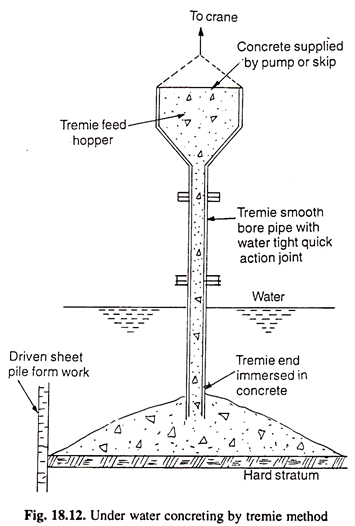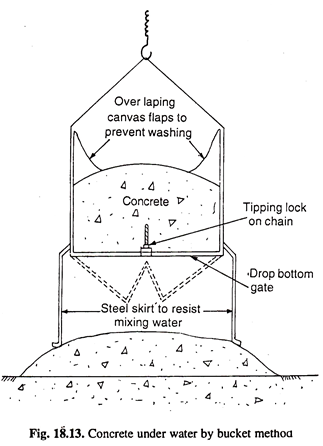Following methods can be adopted for placing concrete under water. The methods are: 1. Placing of Concrete in Dewatered Caissons or Coffer Dams 2. Tremie Method 3. Bucket Placing Method 4. Concrete Filling in Bags 5. Pre-Packed Concrete or Grouting Method.
Method # 1. Placing of Concrete in Dewatered Caissons or Coffer Dams:
In this method same procedure is used as on dry conditions. In case concrete is to be placed under flowing water, then the velocity of flow should not be more than 5 cm/sec, so that mortar is not lost due to the following water. Dewatering by pumping should not be done while concreting is being placed or until 24 hours thereafter. Concrete should be placed continuously till it is brought upto the required height. While placing concrete, the top surface should be kept as nearly level as possible and formation of seams should be avoided.
Method # 2. Tremie Method:
Tremie is a French word, meaning hopper. Tremie is a water tight pipe. It is a composite metallic pipe having diameter varying from 20.0 to 25.0 cm capable of easy coupling for increase or decreases its length. A funnel shaped hopper is fitted to its upper end to facilitate pouring of concrete. The bottom end is closed with a loose plug as shown in Fig.18.12.
The valve at the discharge end is used to dewater the tremie and control the distribution of concrete. The tremie is supported on a working platform above water level and to facilitate the placing, it is built up in 1.0 m to 3.5 m section. The total length of the tremie pipe should be sufficient to allow a free flow of concrete upto the point of placement. The pipe should be strong enough to withstand the external pressure of water in which it is suspended and the partial vacuum pressure developed inside the pipe. A separate lifting device is provided for each tremie with its hopper at the upper end.
ADVERTISEMENTS:
Unless the lower end of the pipe is equipped with an approved automatic check valve, the upper end of the pipe should be plugged with a wadding of gunny sacking or any other approved material before delivering the concrete to the tremie pipe through the hopper, so that when the concrete is forced down from the hopper to the pipe, it will force the plug down the pipe and out of the bottom end establishing a continuous stream of concrete, and the water in the pipe if any is displaced by concrete.
Working Process:
At the place of concreting, sheet piles form work is driven inside the water and the tremie pipe is lowered into position and the discharge end is kept as deeply submerged beneath the surface of freshly laid concrete as the head of concrete in tremie permits. The tremie pipe is lifted up and a slight jerk is given by a winch and pulley arrangement to discharge the concrete down. During concreting air and water must be excluded from the tremie by keeping the pipe full of concrete all the time.
ADVERTISEMENTS:
As the concreting proceeds, the pipe should be raised slowly to have a uniform flow of concrete, and the concrete flows out wards. During concrete operation care should be taken to maintain the continuity of concreting without breaking the seal provided by the concrete cover over the discharge end i.e., it should never be emptied. If this seal is required to be broken, the tremie should be lifted up and plugged before re-concreting is started.
During all the time after starting placing concrete till the end of completion the lower end of tremie should remain below the top surface of plastic concrete. This will cause the concrete to build up from below instead of flowing out over the surface avoiding the formation of laitance layers.
If the charge in the tremie is lost while depositing the concrete, the tremie should be raised above the concrete surface and unless sealed by a check value, it should be re-plugged at the top end as at the beginning, before refilling the depositing concrete. The tremie should never be moved laterally through the freshly placed concrete. For shifting the tremie to a new position it should be lifted vertically above the surface of concrete and shifted to its new position.
If the concrete is to be placed in large quantities, it is preferable to place concrete simultaneously and uniformly through a number of tremie pipes rather than sifting a single tremie pipe from one point to another point. The spacing between the tremies should be between 3.5 m to 5.0 m and the end tremies should be about 2.5 m away from the form work.
ADVERTISEMENTS:
The risk of segregation and non-uniform stiffening can be minimised by maintaining the concrete surface in form work as level as possible and by providing a continuous and rapid flow of concrete.
Advantages:
If the work is executed properly, this method has the following advantages:
1. The concrete is not affected by the flowing water, except the top layer. The top layer may be cut off to remove the affected concrete at the end of the whole operation.
ADVERTISEMENTS:
2. Under water concrete dos not need compaction as concrete automatically gets compacted by the hydrostatic pressure of water.
3. The concrete is of such a high consistency which normally does not require compaction.
Disadvantage:
Concreting by tremie method requires high water/cement ratio for obtaining high consistency, which reduces the strength of concrete. But now, with the use of some plasticizer a concrete with as low w/c ratio as 0.3 or even less can be placed by tremie method.
ADVERTISEMENTS:
Precautions:
During the course of concreting no pumping of water should be done. If pumping is done simultaneously, it may suck the cement particles from the concrete.
Method # 3. Bucket Placing Method:
In this method the concrete is deposited under water by a bottom opening bucket. The buckets usually are fitted with bottom roller or drop bottom gates as shown in Fig.18.13. The gate opens freely outward when tripped. The bucket is filled completely with concrete and its top covered with a canvas cloth or gunny sack and lowered slowly to avoid backwash or disturbance to concrete as the bucket is lowered into the water.
Some buckets are provided with a special base, which limits the disturbance to the concrete during discharge operation and also when the empty bucket is raised up from the freshly laid concrete. The bucket is lowered by a crane upto the bottom surface of the concrete and then opened either by a suitable arrangement from the top or by a diver. It is essential that the concrete be discharged directly on the surface on which it is to be deposited. The early discharge of bucket, by which the fresh concrete drops through water, must be avoided.
Advantages:
Following advantages of this method are observed:
1. The concreting can be carried out at the considerable depths below water surface.
2. Slightly stiffer concrete than tremie method can be used.
Disadvantages:
The main disadvantage of this method is the difficulty in keeping the top surface of the placed concrete reasonably level.
Method # 4. Concrete Filling in Bags:
In this method the jute sacks or coarse cloth bags of minimum capacity of 0.028 m3 are filled about 2/3 with concrete and the spare part of the bag is turned down and tied securely. The bags are tied in such a way that they can be accommodated readily in a profile of the surface on which they are placed. The properly filled bags are lowered into the water and placed carefully in header and stretcher courses as in brick masonry construction with the help of divers so that the whole mass is interlocked.
Advantages:
This method is found to have the following advantages:
i. Comparatively lean mixes may be used provided sufficient plasticity is retained.
ii. No form work is necessary in this method.
Disadvantages:
i. This method is slow and laborious as the accurate positioning of the bags in place can only be accomplished by the divers.
ii. Voids in adjacent bags are difficult to fill.
iii. There is little bonding other than developed by the mechanical interlock between bags.
iv. The method comparatively is costly as more labour is involved in filling and tying them.
v. This method is suitable for placing concrete in shallow water only.
Method # 5. Pre-Packed Concrete or Grouting Method:
In this method a series of round cages are made of 50 mm mesh of 6 mm steel bars and extended upto the full height to be concreted. These cages are laid vertically over the full area to be concreted such that the distance between the centres of the cages and also to the faces of the concrete should not exceed one metre. The size of the stone aggregate should neither be less than 50 mm nor more than 200 mm. This aggregate should be wetted before depositing it outside the steel cages over the full area and height to be concreted. While depositing the aggregate, care should be taken that no cage is displaced from its position.
After depositing the aggregate, the cement sand grout of 1:2 proportion and water/cement ratio not less than 0.6 and not more than 0.9 is prepared in a mechanical mixer. The maximum size of sand may be 5 mm and the cement sand proportion may vary from 1:1.5 to 1:4 depending upon the strength requirements and importance of the work. The prepared grout is sent down through 38 to 50 mm diameter pipe terminating into the steel cage about 50 mm above the bottom of the concrete bed.
The pressure of the grout should be maintained at 2 kg/cm2 to 3 kg/cm2 (0.2 N/mm2 0.3 N/mm2) As the grouting proceeds, the pipe should be raised gradually upto a height of not more than 60 cms above the starting level. After this level, the pipe may be withdrawn from this cage and placed into the next cage. The procedure is repeated till all the cages are grouted upto this level.
After grouting the whole area for a height of about 60 cms, the same operation is repeated for the next layer of 60 cm and the procedure is repeated till the grouting is completed upto the desired height. The grout to be sent down should be sufficient to fill all the voids. The volume of voids may be assumed as 55% of the volume to be concreted or ascertained experimentally. As far as possible concrete should not be disturbed while it is deposited, this will minimise the formation of laitence.
Advantages:
The following advantages have been observed:
1. Grouting or pre-packed concrete exhibits lower drying shrinkage and higher durability.
2. It is more freezing and thawing resistant than ordinary concrete of the same proportions.
Disadvantage:
The rate of development of strength is comparatively slow for the first two months, but the eventual strength is about the same as that of normal concrete.
Grouting method of concreting is very much suited for underground construction and repair work of mass concrete structures such as dams, spillways etc.
The tremie method for under water concreting most commonly is used in U.S.A. and USSR, while in Holland where large volumes of concrete are placed under water, the usual method employed is that of placing by bucket method. The bag method almost is obsolete now. However it may be used for building up permanent under water form work.

